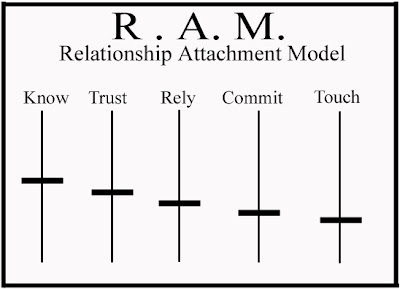"Satisfaction in marriage does not come from getting the desired behavior from your spouse, it comes from feeling mutually understood."
One of the traits that sets humans apart from other animals is our ability to speak. Speech allows us to express ourselves with greater clarity and accuracy in order to communicate to those we interact with what we feel and think. However, it doesn't matter how precise we try to be with our words, we always have opportunities to miscommunicate with each other and, if we aren't careful our natural man will take the wheel, blurring that trait that distinguishes us from animals.We tend to be quite nifty with our words, yet it is interpreting nonverbal cues that usually gets us in trouble. "Estimates are that anywhere from 50 to 80 percent of the meaning we convey is through the nonverbal part of our communication." Kinds of nonverbal communications vary everywhere from the clothing we wear to the tone in which we speak. Facial expressions, eye movement, and the way we touch people can be all too easily misinterpreted. Communication is an interactive process. Lets explore it!
"Begin at the left side, labeled the "sender." This is the person who initiates the conversation, who wants to share some idea or feeling. the first step is to encode the idea and/or feeling into language, that is, into words that will hopefully convey the meaning to the other person. If you are angry with someone, for example, you could phrase your anger in various ways. You could be subtle: "I'm not in a good mood." Or you could be direct: "I'm angry with you just now." Or you could phrase it in any number of other ways. The point is, you must encode your ideas and feelings in a way that will best convey what you want the other person to know.
The encoded message is transmitted through the media, which, in communication, are the verbal and nonverbal means of conveying meaning to someone. Thus, you can express your anger both in words and in your demeanor and gestures (e.g., a scowl, a clenched fist, and a loud voice). The dotted line from "encode message" back to ideas and feelings indicates that as you transmit the message you hear your own words and evaluate them. That ives you an opportunity to revise what you say in order to clarify the message. For example, if you blurt our "I'm not in a good mood," you may realize as you hear the words that they are not adequate, and say, "No, that;s not what I mean. I'm really angry with you."
The other person, the receiver, must decode your message--interpret your words so that he or she understands your ideas and feelings. The receiver filters the message through his or her own ideas and feelings before encoding a response. In responding to your anger, the other person may realize that he or she is perplexed and encode that message ("You have no right to be angry; I'm the one who should be angry"), and so on. The receiver, in other words, is now a sender and the process continues" (Lauer & Lauer).
Not being able to be understood by those you love most is suffocating. That is why I want to share with you Five Keys of Effective Communication.
- Disarming technique
- Empathy
- Inquiry
- I feel
- Expressing genuine appreciation/admiration.





